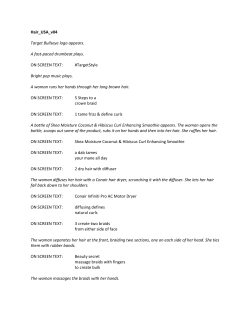
Home-Use Laser and Light Devices for the Skin—An Update
Home-Use Laser and Light Devices for the Skin—An Update Andrei I. Metelitsa, MD, FRCPC,*,† and Jeremy B. Green, MD‡,§ Over the past several years, a number of home-use laser and light skin devices have been introduced for various indications, including photorejuvenation, hair growth, hair removal and acne treatment. Although these devices allow for privacy and a significant cost advantage, they are typically underpowered and afford lower efficacy than their in-office counterparts. A number of these devices have recently received FDA clearance. Although large clinical trials are lacking, dermatologists should familiarize themselves with the various options to help patients assess their clinical value. Semin Cutan Med Surg 30:144-147 © 2011 Elsevier Inc. All rights reserved. KEYWORDS over-the counter, devices, lasers, home-use, light, acne, photorejuvenation, LED, hair removal, hair growth I n recent years several over-the-counter (OTC) cosmetic laser devices have been introduced (Table 1). These instruments provide several advantages for consumers when compared with in-office treatments. By using miniaturized versions of the traditional lasers, patients are able to perform procedures, such as hair removal, in the comfort and privacy of their own home. In addition, home-based treatment is potentially less costly, which appeals to consumers who would otherwise be unwilling to pay higher fees associated with in-office treatments. With adequate education and instruction, patients are able to treat themselves in a safe manner.1 Over-the-counter devices are not without their shortcomings. With the special emphasis on reduced cost and absolute safety for “nonprofessional” operators, these devices are typically underpowered compared with their in-office counterparts, resulting in reduced efficacy and requiring a greater number of treatments. Despite the debate regarding the future of these devices among clinicians, consumers desiring new approaches to esthetic rejuvenation drive the market. *University of Calgary; Institute for Skin Advancement, Calgary, AB, Canada. †SkinCare Physicians, Chestnut Hill, MA. ‡Dermatology & Skin Cancer Institute, Coral Gables, FL. §University of Miami Department of Dermatology & Cutaneous Surgery, Miami, FL. Conflict of Interest Disclosures: All authors have completed and submitted the ICMJE Form for Disclosure of Potential Conflicts of Interest and none were reported. Address reprint requests to Andrei I. Metelitsa, MD, FRCPC, Assistant Clinical Professor of Dermatology, University of Calgary; Institute for Skin Advancement, Calgary, AB, Canada. E-mail: andrei.metelitsa@gmail.com 144 1085-5629/11/$-see front matter © 2011 Elsevier Inc. All rights reserved. doi:10.1016/j.sder.2011.05.005 Photorejuvenation One of the newest indications of OTC devices is photorejuvenation. The PaloVia Skin Renewing Laser (Palomar Medical Technologies, Burlington, MA) is the first handheld, fractional, nonablative diode laser (1410 nm, 15 mJ, 10-ms pulse duration) that is cleared by the U.S. Food and Drug Administration (FDA) for the reduction of fine lines and wrinkles around the eyes (Fig. 1). An assessment of the histologic data after treatment demonstrates formation of vertical microcoagulated columns at approximately 250 m of depth. In a pilot study, 34 subjects with periorbital lines used the device daily for 4 weeks, followed by another 4 weeks of twiceweekly maintenance treatments.2 In a subsequent pivotal study, 90 subjects used the device daily for 4 weeks, followed by 12 weeks of twice-weekly maintenance treatments.2 Assessment of subjects from both studies by blinded evaluators revealed improvement of at least 1 grade in facial wrinkle score among 90% of patients at the end of the active phase and 79% of patients after the maintenance phase. On selfassessment in the pivotal phase study, 87% of patients felt they had reduction in the degree of their wrinkles. It should be noted that special features, including an automatic 8-hour shut-off after 25 scans and a smart sensor that requires fullskin contact, have been incorporated to ensure additional device safety. Another home-based photorejuvenation device, codenamed “Kovar” (a collaborative effort between Solta Medical, Hayward, CA and Philips, Einthoven, Holland) is currently undergoing a pilot study, but has not been cleared by the FDA. This 1435-nm laser uses a high-speed scanner and Home-use laser and light devices for skin 145 Table 1 Select Over-the-Counter Devices and Their Specifications Indication Device Photorejuvenation Palovia skin-renewing laser Kovar Hair MaxLaser Comb Laser Cap Tria laser Silk’n Tanda clear Tria clarifying blue light Omnilux clear-U Hair growth Hair removal Acne Zeno hot spot Thermaclear no! no! skin Claro Specifications Fractional, nonablative laser (1410 nm) Fractional, nonablative laser (1435 nm) 9 laser diodes (655 nm) 224 laser diodes (650 nm) Diode laser (810 nm) Intense pulsed light (475-1200 nm) Blue light-emitting diode (414 nm) Blue light-emitting diode (415 nm) Light-emitting diodes delivering both blue light (415 nm) and red light (633 nm) Heat-based device (118°F) Heat-based device (222°F) Intense pulsed light (450-2000 nm) Intense pulsed light (400-1100 nm) produces fractionated microscopic skin injury at approximately 200 m in depth. A study of 80 patients who received twice-weekly treatments to face, neck, chest, and arms for 8-12 weeks revealed statistically significant improvement in overall appearance, fine lines, pigmentation, age/sun spots, texture, firmness and radiance at 1 and 4 weeks after completion of the course of treatment (personal communication with Dr Christopher Zachary). More than 90% of patients noted an improvement at week 8. Hair-Growth Devices Despite numerous medical advances in dermatology, treatment of androgenic alopecia in both men and women remains challenging. Available medical therapies, including topical minoxidil and oral finasteride, are often considered first line, but their potential side effects, and requirement for long-term daily use prevents many patients from selecting these agents. Hair transplantation is effective, but its costs can be prohibitive for many patients. Low-level light therapy (LLLT) devices that stimulate hair growth have recently become available and provide an appealing option for patients. LLLT has been described in several clinical applications, including wound healing, pain, and antiaging, when used in the red and near-infrared spectrum (600-950 nm). Current LLLT hair growth devices contain low-powered laser diodes with similar wavelengths in the Figure 1 PaloVia Skin-Renewing Laser. FDA Clearance Yes No Yes No Yes Yes Yes Yes Yes Yes Yes Yes Yes region of 630-670 nm. These lasers are thought to induce proliferative activity in hair follicles resulting in terminalization of vellus human hair follicles.3,4 HairMax LaserComb (Lexington International, LLC, Boca Raton, FL) is cleared by the FDA for the stimulation of hair growth (Fig. 2). The device contains a single laser module that emits 9 beams (total maximal output of 45 mW) at a wavelength of 655 nm. The patient must sequentially move the device during treatment to ensure coverage of the entire affected area. In a randomized, double-blind, sham devicecontrolled, multicenter trial of 110 male patients with androgenic alopecia, subjects in the treatment group exhibited a significantly greater increase in mean terminal hair density than subjects in the sham device group (P ⬍ 0.0001).5 Furthermore, patients’ self-assessment at 26 weeks revealed significant improvement in overall hair regrowth from baseline. LaserCap (Transdermal Cap, Inc, Gates Mills, OH) is another LLLT OTC device that is currently undergoing clinical trials in an effort to gain FDA clearance for hair growth. The device contains 224 laser diodes (5 mW each with a total maximum output of 1120 mW) that are affixed to a mesh framework, which fits under a hat or cap. Advantages of this device include greater dosimetry, as well as the convenience of not requiring active combing vs other OTC hair-growth devices. Hair-Removal Devices Given that removal of unwanted hair generates more than US$9 billion annually worldwide, the availability of several OTC devices cleared by the FDA for hair removal is a significant milestone in the esthetic industry.6 Tria Laser (Tria Beauty, Inc, Dublin, CA) is a battery-powered, handheld device that uses an 810-nm wavelength with 3 energy fluence settings (high 22.0 J/cm2, medium 17.5 J/cm2, and low 13.0 J/cm2), 3 respective pulse widths (600, 450, and 300 ms), and a 1.0-cm spot size. Eye-safety technology has been incorporated to eliminate retinal hazards, which obviates the need for protective eyewear during treatment. In a single-site, 2-armed study, 77 appropriate users (naturally light brown A.I. Metelitsa and J.B. Green 146 reduction of 64%. Another study of 20 women treated at the same parameters revealed 40.4%-61% hair reduction 3 months after the third treatment.9 Greater clinical efficacy was demonstrated in a study of 20 patients who received 6 biweekly treatments, with 72% hair reduction noted at their 3-month follow-up.10 However, a smaller study of 10 patients treated with 4-6 similar treatments on a biweekly basis revealed a much lower efficacy, demonstrating hair reduction of 10% at the 3-month posttreatment assessment.11 Mild transient perifollicular erythema was found in 25% to 50% of the treated patients.8,9,11 Reported treatment time of an average axilla was 2-3 minutes. A new model of the device, the SensEpil, has a sensor built into the lamp so it will not flash on skin types V and VI, thereby providing increased safety. Acne Devices Traditional treatment of acne involves the use of topical or systemic antibiotics, benzoyl peroxide preparations, and topical or systemic retinoids. During the past several years, several OTC devices received FDA clearance for the treatment of mild-to-moderate inflammatory acne. Phototherapy can play a role in the treatment of acne by using Figure 2 HairMax LaserComb. to black hair in the treatment area and Fitzpatrick skin types I—IV) were placed into the treatment group designed to measure safety and efficacy from 3 self-administered treatments performed every 3 weeks.7 The nontreatment group consisted of 44 inappropriate users (either naturally white, gray, red, blond hair, or Fitzpatrick Skin types V and VI) who received a single, staff-administered laser pulse at the noncosmetic, hair-bearing site to determine safety of the device. The mean hair reduction 1, 6, and 12 months after completion of the third treatment was found to be 60%, 41%, and 33%, respectively, with transient erythema noted as the only side effect. Treatment duration for an average axilla was typically 10-20 minutes. Silk’n (Home Skinovations, Yokneam, Israel) is another FDA-cleared, portable, low-energy, handheld device that involves the delivery of intense pulsed light at 475-1200 nm (maximum fluence of 5 J/cm2, pulse duration less than 1 ms, rate of one pulse every 3.5 s, and a 2.0-3.0-cm spot size). In the first clinical study, 34 individuals performed 3 treatments at 2-week periods on 92 sites.8 Three-month follow-up revealed hair reduction in 95% of patients, with an average Figure 3 Tria Clarifying Blue Light. Home-use laser and light devices for skin a property of the pathophysiology of the condition. Blue light is an effective wavelength for destruction of Propionibacterium acnes, given the absorption peak of a major endogenous porphyrin produced by the bacteria at 415 nm.12-14 Tanda Clear (Pharos Life Corporation, Cambridge, ON) is a 414-nm blue light emitting diode device that is FDA cleared for the treatment of acne. In a study of 21 subjects treated once daily for 6 minutes during an 8-week period, statistically significant reduction in open comedones (30.4%-50%) and a 35.6% reduction in papules was seen. Tria Clarifying Blue Light (Tria Beauty, Inc, Dublin, CA) is another blue light-emitting diode device that involves 5-minute daily treatments (Fig. 3). Although it has been FDA-cleared for OTC use, no published studies assessing its efficacy are available. One of the limitations of using blue light therapy in the treatment of acne is its depth of skin penetration. Combination blue and red light therapy has been incorporated into acne treatments with superior synergistic results.13 This is thought to be attributable to the longer wavelength of red light, its subsequent deeper skin penetration, and its purported anti-inflammatory properties.12 The Omnilux Clear-U (Photo Therapeutics, Inc, Carlsbad, CA) OTC FDA-cleared device incorporates light-emitting diodes delivering both blue light at 415-nm wavelength (40 mW/cm2) and red light at 633 nm (70 mW/cm2). This device was evaluated in 21 subjects with inflammatory acne who over the course of four weeks self-administered four 20-minute blue and four 30minute red light treatments with several day intervals between the alternating light treatments.15 A reduction in lesion count of 69% was noted 8 weeks after the final treatment. Two of the FDA-cleared OTC devices use heat to treat individual acne lesions. Zeno Hot Spot (Tyrell, Inc, Houston, TX) and Thermaclear (Therative, Inc, Livermore, CA) induce activation of heat-shock proteins, causing bacterial self-destruction with subsequent reduction in P acnes colony counts.16 Zeno Hot Spot heats to 118°F and requires application for 2.5 minutes. In one study, investigators showed resolution of up to 55% of the lesions after five days of treatment (Bruce S, Conrad C, Peterson R, et al: Significant Efficacy and Safety of Low Level Intermittent Heat in Patients with Mild to Moderate Acne, unpublished data; available at http://www.myzeno.com). In contrast, Thermaclear heats to 212°F and is only applied for 2.5 seconds, with 44% of the lesions resolving at 5 days.17 Combination of light and heat therapy is incorporated in several novel FDA-cleared OTC acne devices. The no! no! skin device (Radiancy, Inc, Orangeburg, NY) delivers a flash of intense pulsed light of 450-2000 nm with a fluence of 6 J/cm2 per treatment cycle lasting 10 seconds. In a 2-center, placebo-controlled, double-blind study of 63 subjects treated twice daily for 4 days, investigators demonstrated an improvement rate of 76.7% for the active arm at 24 hours versus 15.6% for the placebo arm, and statistically significant shorter lesion resolution time was found.16 The authors suggested that the device is therefore most effective when used at the onset of a developing acne lesion. Claro (Solta Medical, Hayward, CA) also uses the combi- 147 nation of light and heat concept, with intense pulsed light of 400-1100 nm and a fluence of 6 J/cm2 per 6-second treatment cycle. According to a company-led evaluation, up to 94.8% reduction in P acnes is measured after a 6-second exposure, however no published information is available. Conclusions During the past years, several OTC devices designed for photorejuvenation, hair reduction, hair growth, and acne treatment have been introduced to the market. Given this trend, additional OTC devices will undoubtedly be available for patients soon. A number of these instruments can deliver clinical results while incorporating safety features that make them acceptable treatment options. Unfortunately, extensive scientific evaluation of these treatment modalities is limited, and clinicians will find it difficult to truly ascertain which devices optimize efficacy. Irrespective of this, it behooves dermatologists to learn about available devices to properly guide their patients. References 1. Rohrer TE, Chatrath V, Yamauchi P, et al: Can patients treat themselves with a small novel light based hair removal system? Lasers Surg Med 33:25-29, 2003 2. Leyden J, Stephens TJ: Multi-center clinical trials of home-use nonablative fractional laser device for wrinkle reduction [abstract 102]. Lasers Surg Med 42 Suppl 22:34, 2010 3. Bernstein EF: Hair growth induced by diode laser treatment. Dermatol Surg 31:584-586, 2005 4. Bouzari N, Firooz AR: Lasers may induce terminal hair growth. Dermatol Surg 32:460, 2006 5. Leavitt M, Charles G, Heyman E, et al: HairMax LaserComb laser phototherapy device in the treatment of male androgenetic alopecia: A randomized, double-blind, sham device-controlled, multicentre trial. Clin Drug Invest 29:283-292, 2009 6. Hodson DS: Current and future trends in home laser devices. Semin Cutan Med Surg 27:292-300, 2008 7. Wheeland RG: Simulated consumer use of a battery-powered, handheld, portable diode laser (810 nm) for hair removal: A safety, efficacy and ease-of-use study. Lasers Surg Med 39:476-493, 2007 8. Mulholland RS: Silk’n—a novel device using Home Pulsed Light for hair removal at home. J Cosmet Laser Ther 11:106-109, 2009 9. Alster TS, Tanzi EL: Effect of a novel low-energy pulsed-light device for home-use hair removal. Dermatol Surg 35:483-489, 2009 10. Gold MH, Foster A, Biron JA: Low-energy intense pulsed light for hair removal at home. J Clin Aesthet Dermatol 3:48-53, 2010 11. Elm CM, Wallander ID, Walgrave SE, et al: Clinical study to determine the safety and efficacy of a low-energy, pulsed light device for home use hair removal. Lasers Surg Med 42:287-291, 2010 12. Cunliffe WJ, Goulden V: Phototherapy and acne vulgaris. Br J Dermatol 142:855-856, 2000 13. Papageorgiou P, Katsambas A, Chu A: Phototherapy with blue (415 nm) and red (660 nm) light in the treatment of acne vulgaris. Br J Dermatol 142:973-978, 2000 14. Bhardwaj SS, Rohrer TE, Arndt K: Lasers and light therapy for acne vulgaris. Semin Cutan Med Surg 24:107-112, 2005 15. Sadick NS: Handheld LED array device in the treatment of acne vulgaris. J Drugs Dermatol 7:347-350, 2008 16. Sadick NS, Laver Z, Laver L: Treatment of mild-to-moderate acne vulgaris using a combined light and heat energy device: Home-use clinical study. J Cosmet Laser Ther 12:276-283, 2010 17. ThermaClear for acne. Med Lett Drugs Ther 49:51-52, 2007
© Copyright 2025













